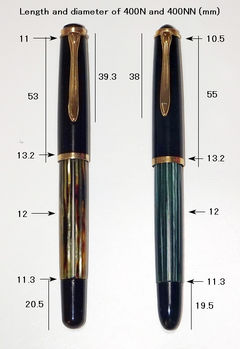top of page
Pelikan 400NN⁽¹⁾ (1956-1965)
Model 400NN⁽¹⁾ was introduced in April 23, 1955 (Pelikan Schreibgeräte). Another "N" was added to the suffix⁽¹⁾. There were several differences in design, construction, and material from model 400N. The changes, including those made along the way, are as follows;
-
Cap*: The cap top became about 1.3 mm smaller in diameter (than model 400N). Its shape became more pointed and integrated into the cap itself (Pelikan’s Perch). The cap tube became about 2 mm longer, and the end on the cap top side became about 0.5 mm smaller in diameter. The engraving on the cap ring was "PELIKAN 400 - GERMANY"⁽¹⁾. The clip became about 1.3 mm shorter but further slimmer in the mid-portion.
-
In 1958, the cap tube was equipped with "Kappensicherung" (cap safety device) (Pelikan Schreibgeräte, Pelikan’s Perch)⁽²⁾.
-
-
Nib unit: Feed was same as the predecessors (please see Pelikan 400 (ca.1952)).
-
Nibs had a fir tree engraving, but from the late production, the diagonal lines no longer merged into the central slit⁽³⁾.
-
Early collars were made of ebonite. However, the transparent polystyrene collar was introduced likely in the early 1960s (Pelikan’s Perch)⁽⁴⁾.
-
-
Body*: The grip section, barrel, and piston seal seemed to be identical to model 400N (Pelikan’s Perch). The turning knob became about 1 mm shorter and more pointed.
-
Color: colors of barrel and cap, and their combination were almost same as model 400 (please see Pelikan-collectibles and Pelikan’s Perch).
-
Dimension*: The diameter in the middle was almost same as model 400N, but the length was about 2 mm increased (400N: 127.5 mm vs. 400NN: 129.5 mm). For a more detailed comparison of model 400, 400N, and 400N, please see Pelikan’s Perch.
As you can see from the photo of the three 400s side by side (please see below), model 400NN became even longer and more "streamlined" (although not strictly speaking) than the predecessors.
Like model 400/400N, some 400NN models were exported (Pelikan-collectibles)⁽⁵⁾.
Model 400NN had a full range of (semi) luxury models, befitting a flagship model. They were similar to those of model 400 (please see below).
The situation surrounding Pelikan and fountain pens changed dramatically during the production of the 400 series (400, 400N, and 400NN). Fountain pens had entered a period of decline, pushed aside by ballpoint pens. While some manufacturers (including Pelikan) tried to survive by introducing cartridge-type pens and lower-end pens, others went out of business or were absorbed by other manufacturers (Ravens March Fountain Pens).
In September 1958, Pelikan introduced model P1, the first of a new generation of fountain pens that had been completely redeveloped in construction and design (Pelikan-collectibles.com). As a result, model 400NN vacated its flagship position, as seen in Pelikan catalog No.100A/4 (1962). But, different from model 100N and 400, model P1 was not as successful as expected and was discontinued in 1963 before its predecessor. In 1960, model Pelikano was introduced for school use. Based on the designs of P1, the model was Pelikan's first cartridge/converter filler. In 1961, following the success of Pelikano, cartridge/converter filler pens for adults (models P25 and P15) were introduced.
Model 400NN was discontinued on July 28, 1965⁽⁶⁾. This marked the disappearance of the classic style fountain pens dating from 1929.
Note;*The measurements and engraving are based on my own pen. Therefore, there may be slight differences with other pens.
⁽¹⁾Contrary to model 100N, the suffix "NN" was only used internally, and was never published in any price list. The differentiation by the suffix was only used in spare parts product leaflets and in internal product descriptions (Pelikan Schreibgeräte).
⁽²⁾A built-in springy steel ring inside the cap tube prevented the pen from accidentally opening in the pocket. Initially, it was thought to be employed only for a short period of time (Pelikan Schreibgeräte), according to @stoen, it was built-in for much longer than previously considered (1958/59): possibly until the end of production line in both models (1965).
⁽³⁾According to Pelikan catalogs, the changeover seemed to be around 1964 (please compare Pelikan catalog No.110B (1963) and Pelikan catalog (1964)). Do you know why the design was changed? I have read elsewhere (万年筆おやじの備忘録) that this could be a yield issue in nib production. If a slit is made in a nib with merging diagonal lines, the diagonal lines will not merge cleanly when the slit is misaligned. If the diagonal lines do not merge, such problem can be avoided even if the slit is misaligned. This is just a guess.
⁽⁴⁾Succumbing to the lure of “high-tech plastics” (RichardsPens.com), Pelikan began to manufacture collars from this abundant and inexpensive material (Pelikan’s Perch). But the polystyrene collar was brittle and had significant failures over time in all the models which used it (Pelikan’s Perch).
⁽⁵⁾Model 400NN with 'EXPORT' engraving on the barrel are occasionally found.
⁽⁶⁾Apart from the collar, model 400NN was a very complete model, both functionally and cosmetically, and the fact that it was produced for nine years speaks for itself.
Pelikan 400, 400N, and 400NN
By courtesy of Christof Zollinger.
Pelikan 400NN transparent demonstrator (ca.1956?)
Without cap safety device.
Pelikan 400NN transparent demonstrator (ca.1958)
With cap safety device. Please compare with the pen above. Click to see the cap safety device of another pen.
Pelikan 400NN (ca.1964)
My collection.
Pelikan 400NN (ca.1964)
The cap ring is attached upside down (production error).

Pelikan 400NN (ca.1964)
Export model. "EXPORT" engraving on the barrel.

Pelikan 500NN
Gold filled (cap tube, crown, and clip)

Pelikan 520NN
All gold filled (cap top, cap tube, crown, clip, sleeve, and turning knob).

Pelikan 600NN
Solid 14 carat gold (cap top overlay, cap tube overlay, crown, and clip).

Pelikan 700NN
All in solid 14 carat gold (cap top overlay, cap tube overlay, crown, clip, sleeve, and turning knob overlay).

bottom of page






















